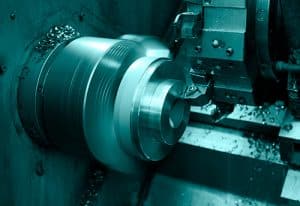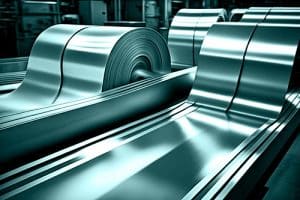From Cradle to Cradle:
Unveiling the Environmental Impact of Metal Production Through Life Cycle Assessments
In an era dominated by sustainability concerns, industries are increasingly turning to comprehensive tools like Life Cycle Assessments (LCAs) to evaluate the environmental footprint of their processes. Nowhere is this more critical than in the metal production industry, where materials like steel, aluminum, and titanium play a pivotal role in modern infrastructure. In this blog post, we’ll explore the significance of Life Cycle Assessments and how they shed light on the environmental impact of metal production, uncovering the journey of these materials from cradle to grave, and outlining the impact regulatory bodies will have on companies emissions reporting.
Understanding Life Cycle Assessments (LCAs)
At its core, a Life Cycle Assessment is a systematic approach to evaluating the environmental aspects and potential impacts of a product or process throughout its entire life cycle. This encompasses everything from raw material extraction and production to transportation, use, and disposal. LCAs offer a comprehensive environmental analysis, enabling industries to identify hotspots in their processes and make informed decisions to reduce their environmental footprint.

Conducting a comprehensive Life Cycle Assessment (LCA) in the metal production industry requires a systematic approach, robust methodologies, and accurate data. Companies utilize various methods and tools to perform LCAs, ensuring a thorough understanding of the environmental impacts associated with their products.
Challenges in LCAs involves navigating issues such as ensuring data quality and availability across the entire life cycle, defining accurate system boundaries to avoid skewed representations, adapting to the dynamic nature of the industry with continuous technological advancements through regular updates, and acknowledging uncertainties and assumptions inherent in LCAs, which companies must transparently communicate to maintain assessment credibility.
Why LCAs Matter in Metal Production
Resource Extraction and Processing: The journey of metals begins with the extraction of raw materials. Steel, often derived from iron ore, aluminum from bauxite, and titanium from minerals like ilmenite, all involve resource-intensive extraction processes. LCAs quantify the environmental impact of these activities, helping industries minimize the ecological toll of obtaining these crucial materials. The process of recycling metals, such as steel, aluminum, and titanium, not only conserves precious resources but also significantly reduces greenhouse gas emissions compared to traditional methods relying on virgin materials. For instance, utilizing recycled steel can result in energy savings of up to 75% and cuts CO2 emissions by substantial margins.

Manufacturing Processes: Once the raw materials are procured, they undergo complex manufacturing processes. LCAs break down the environmental impact of each step, offering insights into energy consumption, emissions, and waste generation. Metal producers are increasingly embracing innovative technologies to revolutionize their production processes and significantly reduce CO2 emissions. One transformative approach involves transitioning from traditional blast furnace methods to alternative technologies, such as electric arc furnaces or hydrogen-based processes. Additionally, exploring carbon capture and storage (CCS) technologies is gaining traction across various metal production processes, allowing for the capture and storage of CO2 emissions before they enter the atmosphere.
Transportation and Distribution: The environmental impact extends beyond the production site. LCAs consider the energy and emissions associated with transporting raw materials, intermediate products, and finished goods. This aspect is particularly crucial in the globalized metal industry. Logistics, while an integral aspect of metal production, tends to have a relatively minimal impact on the overall CO2 emissions compared to the primary stages of production. One illustrative example is the transportation of raw materials to manufacturing facilities. While the shipping and handling of these materials involve energy consumption and emissions, the scale of emissions is often overshadowed by the more carbon-intensive processes within the production chain. Suppose a steel production facility emits 2 tons of CO2 for every ton of steel produced, with logistics contributing to only 0.2 tons of CO2 in transporting raw materials to the facility. In this scenario, logistics would account for just 10% of the total emissions associated with steel production.
Product Use and End-of-Life Management: LCAs account for the environmental impact during the use phase of metal products, such as buildings, vehicles, and consumer goods. Additionally, they assess the end-of-life scenarios, considering recycling, reuse, or disposal. Out of the various metal groups, titanium faces recycling challenges stemming from the irregular and limited availability of quantities. Unlike more established recycling practices in steel and aluminum, recycled titanium feedstock is often scarce and inconsistently sourced. The quantities available for recycling are significantly lower due to the specialized applications of titanium in industries like aerospace and medical, where products tend to have longer lifecycles and are not as readily available for recycling.
Methods Employed in Conducting Life Cycle Assessments (LCAs)
The first step in conducting an LCA is defining the goals and scope of the assessment. Companies must clearly articulate the purpose of the study, identify the boundaries of the system being analyzed, and determine the functional unit, which represents the quantifiable performance of the product or process. For a steel manufacturing facility, the goal might be to assess the environmental impact of producing one ton of steel over its entire life cycle, from raw material extraction to final disposal.
The distinction between primary and secondary data plays a crucial role in shaping the accuracy and reliability of environmental assessments. Primary data refers to information collected directly from the specific processes and operations under investigation. This firsthand data is often obtained through on-site measurements, monitoring, or surveys tailored to the specific study. While primary data offers a high degree of accuracy and relevance to the particular system being analyzed, it can be resource-intensive, time-consuming, and, in some cases, challenging to obtain due to proprietary concerns or operational constraints. On the other hand, secondary data involves utilizing existing data from literature, databases, or industry averages to model the environmental impact of a system. While secondary data can expedite the LCA process and reduce costs, it may lack the specificity required for certain processes, potentially introducing uncertainties and assumptions into the assessment. The challenge lies in striking a balance between the precision of primary data and the convenience of secondary data to ensure that the LCA findings accurately reflect the environmental footprint of the studied product or process.
Life Cycle Inventory (LCI)
The Life Cycle Inventory is the compilation and quantification of inputs and outputs for each stage of a product’s life cycle. This involves collecting data on raw material extraction, energy consumption, emissions, waste generation, and transportation. In the case of aluminum production, the LCI would include data on bauxite mining, alumina refining, aluminum smelting, and transportation of raw materials and finished products.
Life Cycle Impact Assessment (LCIA)
The Life Cycle Impact Assessment is the stage where the collected inventory data is translated into potential environmental impacts. LCIA involves assessing the environmental significance of identified inputs and outputs, often using impact categories such as global warming potential, acidification, eutrophication, and resource depletion. Example: LCIA for steel production might quantify the impact on climate change by assessing the greenhouse gas emissions associated with the production processes.
Interpretation
Interpretation involves analyzing and synthesizing the results of the LCA to draw conclusions and make recommendations. This phase considers the context of the study, uncertainties in the data, and potential improvements to reduce environmental impact. The interpretation of an LCA for titanium production could lead to recommendations for optimizing energy use in the titanium sponge production stage to reduce overall environmental impact.
Software Tools and Databases
To facilitate the complex calculations and analyses involved in LCAs, companies often rely on specialized software tools and databases. These tools streamline the process, ensure consistency, and allow for easier updates as new data becomes available. SimaPro, GaBi, and openLCA are popular LCA software tools that provide databases of environmental impact data, allowing companies to input their specific data and conduct analyses.
Environmental Product Declarations (EPDs)
As a means of transparently communicating the results of LCAs, companies often generate Environmental Product Declarations (EPDs). EPDs provide standardized information about the environmental performance of a product or system, allowing consumers and stakeholders to make informed decisions.
Comparative LCAs
To make informed decisions, companies often conduct comparative LCAs, where they assess different product or process alternatives. This approach helps identify options with lower environmental impact, guiding companies toward more sustainable practices. A manufacturer considering different steel production methods might conduct a comparative LCA to evaluate the environmental implications of traditional blast furnace methods versus emerging hydrogen-based processes.
Publication
The publication and marketing of LCAs and EDPs require adherence to rigorous standards set forth by the International Organization for Standardization (ISO). Specifically, ISO 14040 and ISO 14044 outline the principles, framework, and requirements for conducting LCAs. Before a company can publish and market LCA results, it must follow a meticulous approval process. This process involves a thorough review of the LCA methodology, data quality, and the transparency of assumptions and uncertainties. Independent third-party verification, often conducted by accredited certification bodies, plays a crucial role in ensuring the credibility and reliability of the LCA findings. Once the LCA conforms to ISO standards and successfully passes the verification process, the company can proceed to publish and market the results with the ISO-compliant label. This certification not only enhances the credibility of the LCA but also provides consumers and stakeholders with confidence in the accuracy and transparency of the environmental claims made by the company.
Impact of Regulatory Bodies on Emissions Reporting
Global regulatory bodies having started mandating emissions reporting, especially in sectors like metal production with substantial greenhouse gas emissions. This shift towards transparency and accountability compels industries to disclose comprehensive carbon footprints. While this represents a positive step towards sustainability, challenges arise, demanding accurate data and standardized methodologies. Nevertheless, this challenge stimulates innovation, encouraging companies to explore advanced technologies. The global trend towards integrated emissions reporting and LCAs is evident in collaborative initiatives like the Paris Agreement, emphasizing the shared responsibility to reduce emissions.
Forging a Sustainable Future Through Informed Choices
Life Cycle Assessments stand as a powerful tool in the journey towards sustainable metal production. As companies navigate the intricate web of processes involved in extracting, processing, and utilizing metals, LCAs provide a roadmap for minimizing environmental impact and empower industries to make informed decisions for a greener future.
From the extraction of iron ore for steel to the intricate processes of aluminum smelting and the energy-intensive production of titanium, LCAs offer a comprehensive understanding of the environmental footprint of these materials. By employing robust methodologies, leveraging innovative technologies, and engaging stakeholders, companies can make informed decisions that pave the way for a more sustainable and environmentally conscious future in metal production.
As the global community increasingly recognizes the urgency of innovations in sustainability, the role of LCAs becomes even more critical. It is through these assessments that industries can identify opportunities for improvement, adopt cleaner technologies, and contribute to a circular economy where materials are used, reused, and recycled in a closed-loop system. The journey from cradle to grave for metals is being redefined through the lens of Life Cycle Assessments, forging a path towards a more sustainable, resilient, and responsible metal production industry.